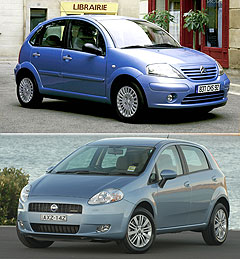Make / Model Search
News - General News‘Green’ car incentives on the cardsGreen push: The Toyota Prius could be a winner from possible incentives to promote the sale of more fuel-efficient cars. Tax probe to look at financial incentives for fuel-efficient cars6 Jul 2009 STATE and federal governments have put the wheels in motion for a possible national financial incentive scheme to encourage car buyers to purchase more fuel-efficient vehicles. The Council of Australian Governments (COAG) – which includes the prime minister Kevin Rudd and all state premiers and territory chief ministers – agreed in Darwin last week to ask the Henry Tax Review to consider the merit of such incentives. It also asked for an assessment of the merits of differential stamp duty and registration regimes linked to environmental performance. COAG also ordered an assessment of ways of reducing CO2 emissions from motor vehicles (see separate story) and agreed to improve availability of fuel consumption data for consumers. The Henry Tax Review – spearheaded by treasury secretary Dr Ken Henry – has already embarked on a wide-ranging review of Australia’s tax system. It is due to deliver its findings to the federal government later this year.  Left: Citroen C3. Below: Fiat Punto. Left: Citroen C3. Below: Fiat Punto.Federal Chamber of Automotive Industries (FCAI) chief executive Andrew McKellar said the referral of such incentives to the Henry Review was “entirely appropriate”. “The terms of reference allow for such a review of stamp duty and other charges and taxes,” he said. “We will definitely be making a submission.” Mr McKellar said it was the FCAI’s view that there was plenty of scope for the states to review stamp duty. “In fact, we would like to see them go even further and abolish stamp duty altogether,” he said. The FCAI has already made submissions to the Henry Review on the Fringe Benefits Tax and Luxury Car Tax. The review is almost certain to consider schemes that encourage more fuel-efficient vehicles in Queensland and Australian Capital Territory. In Queensland, stamp duty is graded, depending on number of engine cylinders or if the car is a hybrid. For example, on the $30,000 car, stamp duty for a hybrid is $600. A four-cylinder car would have a $900 charge, while a six-cylinder vehicle has $1050 payable in duty, and an eight-cylinder car $1200. The duty goes up or down, depending on the overall price. The ACT’s Green Vehicles Duty Scheme – introduced last year – has a graded stamp duty payment scheme to encourage car buyers to think green in the showroom. The system is based on the federal government’s Green Vehicle Ratings Guide, which awards star ratings of between one and five for fuel efficiency, using a score out of 20. The ACT system then groups these ratings into four categories, from A to D. Buyers of the most efficient five-star A-rated vehicles, such as the Toyota Prius, Citroen C3 and Fiat Punto, pay no stamp duty. This means a saving of about $1100 in stamp duty on a Prius. B-graded or four- and four-and-a-half-star vehicles cop $2 in stamp duty per $100 of the vehicle price up to $45,000, which represents a $1 discount per $100 on the previous $3 flat rate. Average three- and three-and-a-half-star cars – such as a Mazda3, Ford Falcon XR6 or Kia Carnival – come out even, with a $3 per $100 rate. To discourage high-fuel-use vehicles, buyers of cars with a rating of between one and two-and-half stars pay a penalty rate of $4 per $100. These D-rated vehicles include large SUVs such as the Toyota LandCruiser and Nissan Patrol and V8 cars such as the Holden Commodore SS. One of the beauties of the ACT system is that it is not technology related – vehicles can achieve a high star rating any way the manufacturer chooses. This means that mini cars also enjoy stamp duty concessions, alongside hybrids and soon-to-be-released electric vehicles. Currently, the only federal tax break for environmental cars is via the luxury car tax which applies to all cars priced above $57,009. Vehicles that consume a combined average of less than 7 litres per 100km do not have to pay the tax, up to $75,000. This has upset companies such as Suzuki Australia, which says only the well-heeled can benefit from such an environmental incentive. It wants a system of incentives for cars of any price that achieve high fuel efficiency, such as its forthcoming Suzuki Alto. “Green” vehicle incentive schemes are widespread in other developed countries, including the UK, Japan and the US. However, some of the schemes cover only hybrids or zero-emissions vehicles. In Britain, hybrid vehicles attract a 15 per cent reduction in annual road taxes. In Japan, new hybrids and electric vehicles pay no “weight tax” – a scaled tax depending on the weight of the car. And in the US, a temporary scheme to boost hybrids is operating until March 31 next year. When introduced last year, the scheme provided tax credits of up to $US3500 ($A7184) for buyers of hybrid passenger cars or light trucks. On April 1, it was reduced to a 50 per cent credit (up to $1700) before September 30. From October to March 31, it will be reduced to a 25 per cent credit before cutting out. Read more:Government to look before it jumps on CO2Australian fuel efficiency reform takes next step Industry ready to fight CO2 standards Carbon scheme a free hit for importers: Ford Obama accelerates US emissions rules Oz detox on CO2 Tailpipe tax agenda Industry backs Garnaut plan Government highlights big-car fuel bills |
Click to shareGeneral News articlesResearch General News Motor industry news |









Facebook Twitter Instagram